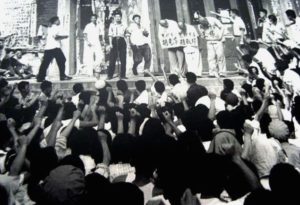Public confessions of guilt by prisoners charged with various crimes are a standard operating feature at the International Criminal Tribunal for the Former Yugoslavia [ICTY]. Dramatic and emotional courtroom confessions, accompanied by undignified self-abasement before the chamber and the prosecution, have been made by some high-profile prisoners as well as lower ranking accused. Their groveling, public expressions of “remorse” and subsequent signing of a “Statement of facts” written by the prosecutor to serve his purposes have not only performed the propaganda function of bolstering the credibility of Prosecution’s case but have also been used to fill factual gaps where evidence was thin or even completely lacking. (The predominantly fanciful “statement of facts” signed by Hague prisoner Dragan Obrenović as part of his plea bargain with the Prosecutor is a case in point: http://www.icty.org/x/cases/obrenovic/custom4/en/facts_030520.pdf)
The prisoner’s goal when entering into such an arrangement with the prosecution typically is to obtain a lower and more predictable sentence in return for agreeing to testify against the co-accused and also in other trials in line with the prosecution-written “factual statement” that he or she had signed. Mrs. Biljana Plavšić, who was a member of the Bosnian Serb Presidency during the conflict 1992 to 1996, is a poignant example of the Tribunal’s sordid plea bargain practice. She was charged with genocide and several other grave crimes. Finally she was pressured, or manipulated, into pleading guilty to “Persecutions on political, racial and religious grounds (crimes against humanity)” in return for a lighter sentence (http://www.icty.org/x/cases/plavsic/cis/en/cis_plavsic_en.pdf ) Although she had no effective power whatsoever within the Presidency of which she was a member, reminiscent of similar confessions of guilt in Stalinist courtrooms and Mao’s “struggle sessions” she stood before the cameras to proclaim her guilt for things she could not have possibly done even if she had been so inclined.
“Struggle session” during the Cultural Revolution in China
Confessions at the Hague Tribunal are a phenomenon that has not attracted the attention it merits. While they do exhibit some elements of Stalinist practice minus overt physical abuse, they are on the whole more akin to the Maoist “struggle session” methodology of cajoling the victim to proclaim remorse for imputed crimes and heap abuse upon him/herself in a public forum, for the edification of the intimidated audience. The crux of the “struggle session” is to stage a situation where victims are publicly humiliated and badgered into confessing imaginary crimes under the pretext of self-criticism and rehabilitation. In a classical study on this subject, “Communist interrogation and indoctrination of ‘enemies of the state’” (https://books.google.rs/books/about/Communist_Interrogation_and_Indoctrinati.html?id=Owi5PQAACAAJ&redir_esc=y ), it is stated that, following the application of techniques designed to induce in the prisoner’s mind a sense of isolation and helplessness, “prisoners usually rationalize a change in attitude and hold it for an indefinite time.” Being “under complete control,” prisoners “have been made to say and do many things which their captors desire.” (Page 60).
But perhaps the most provocative description of the mechanism of “confession,” as it is in fact practiced under the aegis of the Hague Tribunal (although composed as an exposition of the use of this technique in the medieval period), can be found in Michel Foucault’s classic, Discipline and Punishment [Vintage Books, 1995]. There we read the following passages whose obvious applicability to accepted and general practice at ICTY will unfailingly impress most critical minds, especially after viewing the illustrative videos that follow.
Foucault avers that in the period known as the Inquisition “the confession constituted so strong a proof that there was scarcely any need to add others, or to enter the difficult and dubious combinatory of clues; the confession, provided it was obtained in the correct manner, almost discharged the prosecution of the obligation to provide further evidence (in any case, the most difficult evidence). Secondly, the only way that this procedure might use all its unequivocal authority, and become a real victory over the accused, the only way in which the truth might exert all its power, was for the criminal to accept responsibility for his own crime and himself sign what had been skillfully and obscurely constructed by the preliminary investigation. ‘It is not enough’, as Ayrault, who did not care for these secret procedures, remarked, ‘that wrong-doers be justly punished. They must if possible judge and condemn themselves’ (Ayrault, 1. I, chapter 14).” (pp. 36-37)
Foucault goes on to delineate the prime ideological and even pedagogical role assigned to confession as nothing less than that “the accused himself [should take] part in the ritual of producing penal truth. As medieval law put it, the confession ‘renders the thing notorious and manifest’. To this first ambiguity was added a second: as a particularly strong proof, requiring for a conviction only a few additional clues, thus reducing to the minimum the work of investigation and the mechanics of demonstration, the confession was therefore highly valued; every possible coercion would be used to obtain it.” (pp. 37-38)
Indeed, the medieval obstinacy with which the International Criminal Tribunal for the Former Yugoslavia (ICTY) values confession and insists on it as proof of guilt is clearly visible on its web-page, where a section is set aside specifically for a collection of such statements, demagogically supplemented by the statements of presumed victims. Oddly, the confessions (unlike the victim statements) are no longer accessible, but most of them can easily be found on YouTube. Undoubtedly, they will be watched by psychologists and sociologists with considerable professional interest.
In terms of the theoretical framework laid out above, the abject “confession” of Mrs. Biljana Plavšić, delivered in open court at ICTY on December 16, 2002, speaks for itself. It is followed by several other typical ICTY “confessions” which richly illustrate, to paraphrase Dame Rebecca West, “the new meaning of confession” at the dawn of the 21st century.

